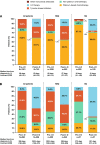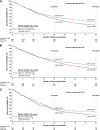Trends in treatment patterns and survival outcomes in advanced non-small cell lung cancer: a Canadian population-based real-world analysis
- PMID: 35264135
- PMCID: PMC8908553
- DOI: 10.1186/s12885-022-09342-5
Trends in treatment patterns and survival outcomes in advanced non-small cell lung cancer: a Canadian population-based real-world analysis
Abstract
Background: As part of the multi-country I-O Optimise research initiative, this population-based study evaluated real-world treatment patterns and overall survival (OS) in patients treated for advanced non-small cell lung cancer (NSCLC) before and after public reimbursement of immuno-oncology (I-O) therapies in Alberta province, Canada.
Methods: This study used data from the Oncology Outcomes (O2) database, which holds information for ~ 4.5 million residents of Alberta. Eligible patients were adults newly diagnosed with NSCLC between January 2010 and December 2017 and receiving first-line therapy for advanced NSCLC (stage IIIB or IV) either in January 2010-March 2016 (pre-I-O period) or April 2016-June 2019 (post-I-O period). Time periods were based on the first public reimbursement of I-O therapy in Alberta (April 2017), with a built-in 1-year lag time before this date to allow progression to second-line therapy, for which the I-O therapy was indicated. Kaplan-Meier methods were used to estimate OS.
Results: Of 2244 analyzed patients, 1501 (66.9%) and 743 (33.1%) received first-line treatment in the pre-I-O and post-I-O periods, respectively. Between the pre-I-O and post-I-O periods, proportions of patients receiving chemotherapy decreased, with parallel increases in proportions receiving I-O therapies in both the first-line (from < 0.5% to 17%) and second-line (from 8% to 47%) settings. Increased use of I-O therapies in the post-I-O period was observed in subgroups with non-squamous (first line, 15%; second line, 39%) and squamous (first line, 25%; second line, 65%) histology. First-line use of tyrosine kinase inhibitors also increased among patients with non-squamous histology (from 26% to 30%). In parallel with these evolving treatment patterns, median OS increased from 10.2 to 12.1 months for all patients (P < 0.001), from 11.8 to 13.7 months for patients with non-squamous histology (P = 0.022) and from 7.8 to 9.4 months for patients with squamous histology (P = 0.215).
Conclusions: Following public reimbursement, there was a rapid and profound adoption of I-O therapies for advanced NSCLC in Alberta, Canada. In addition, OS outcomes were significantly improved for patients treated in the post-I-O versus pre-I-O periods. These data lend support to the emerging body of evidence for the potential real-world benefits of I-O therapies for treatment of patients with advanced NSCLC.
Keywords: Immune checkpoint inhibitors; Immunotherapy; Non-small cell lung cancer; Population based; Real-world evidence; Retrospective cohort study; Survival; Treatment patterns.
© 2022. The Author(s).
Conflict of interest statement
RC, MJD, JRP, and KL are employees of Bristol Myers Squibb. RC and JRP also report stock ownership in Bristol Myers Squibb. MB, AC, and RM are employees of IQVIA. LL is an employee of Epi-Fit and was contracted (paid) as a consultant by Bristol Myers Squibb to support the I-O Optimise initiative. SK reports no relevant conflicts of interest. WYC reports receipt of research funding from Bristol Myers Squibb.
Figures



Similar articles
-
Real-world treatment patterns and survival outcomes for advanced non-small cell lung cancer in the pre-immunotherapy era in Portugal: a retrospective analysis from the I-O Optimise initiative.BMC Pulm Med. 2020 Sep 10;20(1):240. doi: 10.1186/s12890-020-01270-z. BMC Pulm Med. 2020. PMID: 32912174 Free PMC article.
-
Real-world outcomes of immunotherapy-based regimens in first-line advanced non-small cell lung cancer.Lung Cancer. 2021 Jun;156:41-49. doi: 10.1016/j.lungcan.2021.04.007. Epub 2021 Apr 14. Lung Cancer. 2021. PMID: 33894493
-
Evolution of treatment patterns and survival outcomes in patients with advanced non-small cell lung cancer treated at Frankfurt University Hospital in 2012-2018.BMC Pulm Med. 2023 Jan 13;23(1):16. doi: 10.1186/s12890-022-02288-1. BMC Pulm Med. 2023. PMID: 36639770 Free PMC article.
-
Algorithm for the treatment of advanced or metastatic squamous non-small-cell lung cancer: an evidence-based overview.Curr Oncol. 2018 Jun;25(Suppl 1):S77-S85. doi: 10.3747/co.25.3792. Epub 2018 Jun 13. Curr Oncol. 2018. PMID: 29910650 Free PMC article. Review.
-
Rapidly changing treatment algorithms for metastatic nonsquamous non-small-cell lung cancer.Curr Oncol. 2018 Jun;25(Suppl 1):S68-S76. doi: 10.3747/co.25.3839. Epub 2018 Jun 13. Curr Oncol. 2018. PMID: 29910649 Free PMC article. Review.
Cited by
-
Advancing non-small cell lung cancer treatment: the power of combination immunotherapies.Front Immunol. 2024 Jul 2;15:1349502. doi: 10.3389/fimmu.2024.1349502. eCollection 2024. Front Immunol. 2024. PMID: 39015563 Free PMC article. Review.
-
Recent Survival Gains in Stage IV NSCLC by Sociodemographic Strata.JTO Clin Res Rep. 2025 Jan 17;6(4):100798. doi: 10.1016/j.jtocrr.2025.100798. eCollection 2025 Apr. JTO Clin Res Rep. 2025. PMID: 40212792 Free PMC article.
-
Real-World Evidence Study of Patients with KRAS-Mutated NSCLC in Finland.Curr Oncol. 2024 May 11;31(5):2700-2712. doi: 10.3390/curroncol31050205. Curr Oncol. 2024. PMID: 38785486 Free PMC article.
-
Integrating Functional Assessment Into Clinical Decision-Making for Older Adults Across the Cancer Care Continuum.JCO Oncol Pract. 2022 Jul;18(7):e1056-e1059. doi: 10.1200/OP.22.00231. Epub 2022 May 12. JCO Oncol Pract. 2022. PMID: 35549305 Free PMC article. No abstract available.
-
Real-world treatment patterns and outcomes for patients with non-metastatic non-small cell lung cancer: retrospective analyses in Canada, England, and Germany.BMC Pulm Med. 2025 May 27;25(1):265. doi: 10.1186/s12890-025-03715-9. BMC Pulm Med. 2025. PMID: 40426148 Free PMC article.
References
-
- Canadian Cancer Society. Lung cancer statistics. https://www.cancer.ca/en/cancer-information/cancer-type/lung/statistics/.... Accessed 7 Mar 2022.
-
- Herbst RS, Bunn PA., Jr Targeting the epidermal growth factor receptor in non-small cell lung cancer. Clin Cancer Res. 2003;9:5813–5824. - PubMed
MeSH terms
LinkOut - more resources
Full Text Sources
Medical
Research Materials
Miscellaneous

